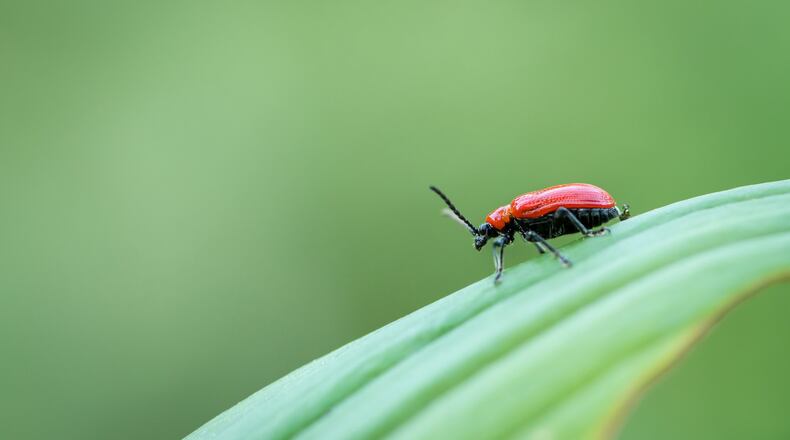Q: I’ve been doing battle with scarlet lily beetles, tapping the adults into hot soapy water. I noticed a few blobs on the leaves and assumed they were either bird droppings or mulch that clung after being thrown onto the bed. I happened to scrape off some, and there was a larva underneath. They are the culprits! I got a chopstick and scraped them off into a zipper bag. Sometimes, I just remove the whole leaf when that’s easier. I inspect twice a week and remove whatever I see. I hope this will help for next year. Thought your readers may be interested.
A: You aren’t alone: I’ve received a half-dozen inquiries from readers this month about these pests. Left unchecked, the invasive insects will devour entire plants. Unfortunately, scarlet lily beetles can be challenging to control because of their unique defense mechanism: Their larvae coat themselves in feces (those blobs you mentioned) to make themselves unappetizing to birds.
Neem oil (extracted from the Neem tree) has shown effectiveness in killing larvae, but it must be applied every five to seven days throughout summer. Given the choice, however, I would stick with your method. It’s natural, free and highly effective.
Q: My Kousa dogwood was beautiful last year; and not so beautiful this year. Do you think the extreme cold this winter is to blame?
A: Kousa dogwoods are reliable spring bloomers, but extended cold temperatures — or shorter, extreme cold snaps — during spring can nip them in the bud. Given the harsh winter we experienced, that’s the most likely explanation for your blossomless tree.
The understory trees, those best-suited to grow under larger trees, particularly thrive in part shade with filtered sun, but too little sunlight also could negatively impact blooming. Another cause could be the recent removal of a larger nearby tree, though that doesn’t appear to be the case as visible in your photo.
Yet another possible culprit is excess fertilizer. Nitrogen applied to the lawn in which the tree is growing could force the tree to direct all its energy toward growth and leaf production, leaving little for blooming.
But if you haven’t fertilized or changed sun exposure, chalk it up to the weather and know the tree isn’t permanently damaged.
Q: I grew a loquat tree from seed after tasting the fruit in Charleston, South Carolina, in 2013. It grew beautifully indoors for several years and even made it through one winter in my Zone 7 side yard, protected by a cold frame. This past winter’s long-lasting, freezing cold was too harsh though, and all its leaves turned brown and brittle. Taking advice I had seen in your previous columns, I nicked a piece of the bark, saw some green beneath, and let it do its own thing. New leaves have started growing. My question is: How should I trim this tree?
A: I’m glad to hear you checked your tree for signs of life before disposing of it. It will be an uphill climb, however, as loquats are typically best suited for zones 8 to 10, withstanding temperatures only as low at 12 degrees. It isn’t absolutely unheard of for a plant with such requirements to survive in Zone 7 climate, but it will need special care and winter protection to do so.
For starters, prune any branches or parts of branches that aren’t bearing leaves; at this point in the season, it’s safe to assume they are dead. In late fall or winter — whenever temperatures first dip to 25 degrees — apply a 4-inch layer of mulch around the tree, keeping it four inches from the trunk. The mulch will help insulate the root system over winter but should be removed in spring to allow the soil to warm.
It’s possible the tree will die back to the ground over winter; if that happens it likely will put forth new growth from its base next year, essentially starting over as a new plant. If the tree survives the winter without dieback, it will resume growing in spring. In fact, if planted in a protected spot and mulched carefully, it may survive many winters and grow to 10 feet tall. Still, it’s unlikely to produce fruit this far north.
About the Author
Keep Reading
The Latest
Featured


